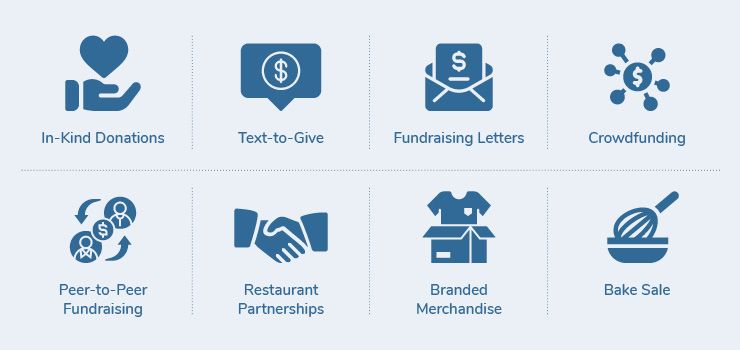Community support is essential for faith-based organizations to thrive. Houses of worship and nonprofits with religious roots have a wide variety of outreach styles and organizational structures, but they all share one common need: to gather the necessary resources to further their mission.
Fundraising makes this goal possible, allowing your organization to conduct outreach and run programs that benefit the whole community. However, there are unique considerations that faith-based organizations like yours need to take into account as you fundraise.
In this guide, you’ll learn all you need to know to get started with faith-based fundraising. We’ll cover the following topics:
At ShopRaise, we understand the value of community support, especially for faith-based organizations. Our years of experience in fundraising have given us insight into how contributions from individual community members can add up to make a positive impact. With the right tools, you’ll be able to take your faith-based fundraising to the next level. Let’s dive in!
Faith-Based Fundraising: An Overview
Although many types of organizations fundraise—such as charities, schools, community groups, and sports teams—faith-based fundraising stands out because of several unique advantages, including:
- Supporter investment. Congregants at houses of worship or donors to faith-oriented nonprofits tend to be loyal to these organizations and want to support them however they can. This occurs most often when your organization creates a strong sense of community—bringing people together around shared beliefs.
- Attitudes of generosity. Many faith traditions promote values like serving those in need and giving back to the community. Supporters who hold these beliefs and prioritize generosity in their daily lives may be more inclined to contribute to your organization and support positive community impact.
- Innovation through technology. Community members’ changing lifestyles, as well as the COVID-19 pandemic, have prompted faith-based organizations to expand their outreach into the digital space. Platforms like your organization’s website, social media, and specific online fundraising programs are great tools for bringing in revenue.
Your website and social media accounts are also helpful in marketing your fundraisers to supporters. In any fundraising content you create, make sure to include your organization’s logo, color scheme, and other brand elements so supporters can trust that their contributions will go directly toward your mission.

9 Faith Fundraising Ideas
While faith-based organizations often rely on individual donations as a major revenue source, you’ll maximize your efforts by adding innovative fundraising ideas to your strategy. Start narrowing down your options with our nine favorite methods.

Featured Faith-Based Fundraising Solution: ShopRaise
ShopRaise is an online shopping fundraiser platform that allows supporters to contribute to your faith-based organization while making everyday purchases. When shoppers use the ShopRaise app and browser extension at participating online retailers, a portion of their total sales goes back to your organization at no additional cost to the supporter.
How to Get Started With ShopRaise
Your faith-based organization can start fundraising with ShopRaise in three easy steps:

- Sign up for ShopRaise. The experts at ShopRaise will walk you through the onboarding process, handle negotiations with retailers, and even create a branded landing page for your organization.
- Spread the word to supporters. Use your organization’s website, email, social media, and other communication channels to instruct supporters on how to download ShopRaise’s app and browser extension. ShopRaise will also design custom marketing materials to help you reach out to supporters regularly to remind them to keep shopping for your cause.
- Track fundraising results. You’ll be able to view real-time data on your fundraiser as supporters start making purchases. These results can provide insight to help you thank participants effectively and adjust your marketing strategy. ShopRaise protects shoppers’ privacy by limiting the details your organization sees to just their names and total amounts raised—only the shopper will know exactly what items they purchased.
When you start fundraising through ShopRaise, your supporters will shop online as they usually do. They’ll pay the same prices and have access to the same discounts they would have otherwise. The only difference is that they’ll use the ShopRaise app and browser extension to make those purchases. Over time, their everyday purchases will add up to significant contributions for your organization!
Why ShopRaise Stands Out
ShopRaise provides a convenient way to contribute to your organization—since shoppers are making purchases they likely would have anyway, they don’t have to spend any additional money to support your mission.
ShopRaise has several benefits for organizations as well. It’s free to join, and once your organization is onboarded, all you have to do is promote the fundraiser and track results as you bring in funds year-round. Also, supporters’ contributions come back as unrestricted revenue, meaning that your organization can allocate the funding toward any necessary section of your budget.
While ShopRaise’s platform has always provided a high level of versatility, it has become even more flexible since the introduction of the Gift Card Store in early 2023. Supporters can buy digital gift cards from more than 200 retailers through the ShopRaise app, and a portion of the proceeds from each sale goes directly to your organization. If your organization uses the legacy online shopping fundraiser features, you automatically have access to the gift card fundraiser functionality as well, so you can earn even more for your cause!
Other Top Faith-Based Fundraisers
Having multiple revenue streams helps your faith-based organization bring in reliable funding. As you develop your fundraising strategy, keep these ideas in mind:

1. In-Kind Donation Drives
In-kind donations are non-financial contributions made to your organization. Instead of collecting revenue and then going out to buy the physical items you need, an in-kind donation drive can help your organization solicit those items directly. For example, you could ask for donations of:
- Equipment for your organization’s facilities, like office chairs or electronics.
- Supplies for upcoming events, such as snacks and water bottles for a kids’ summer fun day.
- Books or other faith-specific resources for your organization’s library.
- Emergency items to give to community members impacted by disasters.
Before hosting a drive, make sure your organization has the types of in-kind donations that would help your mission listed on your donation acceptance policy. In some cases, a well-meaning supporter might try to give an item you can’t accept, like a product where the safety seal is broken or a live animal. But rejecting the donation outright could make your organization seem ungrateful. Pointing the supporter to an official policy will lessen the blow of your “thanks, but no thanks.” Plus, promoting your policy can actually encourage more in-kind contributions!
2. Text-to-Give
Your supporters likely spend a lot of time each day on their smartphones. Why not meet them where they are when asking for financial donations to your faith-based organization?
When you sign up for a text-to-give service, your organization will be assigned a short code. Then, your supporters can text a simple keyword of your choice—for example, GIVE2022—to that code. They’ll receive a link to your online donation page and make their contribution from their smartphone.
If you start a text-to-give campaign, double check that your donation page is optimized for mobile. This way, the form will automatically resize so supporters can fill it out on their phones without accidentally tapping the wrong buttons or having to scroll endlessly.
3. Fundraising Letters
Fundraising letters are a great way to celebrate everything your community has helped you accomplish while you ask for support for the future. For instance, a religious summer camp could send a letter featuring photos of the progress they’ve made on renovating their dining hall. These images can then inspire supporters to donate so the organization can finish the remainder of the construction process.
You’ll likely need volunteers to help you put together and mail your fundraising letters. Consider asking volunteers to hand-write messages and host an envelope-stuffing event to build community among these supporters.
4. Crowdfunding
Especially for organizations that are active on social media, crowdfunding can help you bring in donations from a wide range of supporters. Your organization will set up a campaign through a crowdfunding platform and share the donation page online.
You can motivate supporters to donate to your crowdfunding campaign by:
- Setting a concrete fundraising goal and a hard deadline.
- Sharing periodic progress updates or a fundraising thermometer.
- Including inspiring photos on your crowdfunding page.
Crowdfunding is particularly useful for gathering a lot of small donations in a short period of time to support a specific project or initiative. Letting supporters know exactly what their crowdfunding donations will support helps ensure transparency and build trust in your organization.
5. Peer-to-Peer Fundraising
Like crowdfunding, peer-to-peer fundraising also involves sharing giving campaign pages online. The difference is that your supporters will create individual fundraising pages to collect donations from their friends and family members on your organization’s behalf.
While you can host a peer-to-peer fundraiser on its own, it often works best when paired with an a-thon style event. At this type of event, supporters will do one activity for as long as or as much as they can. Their friends and family then donate to the peer-to-peer campaign based on their loved one’s participation.
Many organizations choose physical activities for peer-to-peer fundraising events, such as walk-a-thons or bike-a-thons, since it’s easy to base donation amounts on the distance a participant walks or bikes. However, you could get creative and base donation amounts on an activity related to your organization’s purpose or faith background. For example, members of a church youth group raising money for a mission trip could ask their friends and family to donate $1 for each Bible verse they memorize by a certain date.
6. Restaurant Partnerships
Both faith-oriented nonprofits and houses of worship can benefit from a restaurant partnership fundraiser. Several large chain restaurants have programs that support nonprofits, and local restaurants might also be willing to partner with your organization.
Once you choose a restaurant, you and your partner will work out a fundraising arrangement. Many restaurant fundraisers involve profit sharing, meaning that the restaurant will donate some of their profits from a particular day to your organization. Other restaurants will set up a donation jar at the register or ask supporters to round up their total sales.
These partnerships are considered passive fundraisers because the restaurant does most of the fundraising work. But your organization still needs to actively market your partnership to encourage your supporters to eat at the restaurant on the day of the profit share or to donate their change.
7. Branded Merchandise Sales
Supporters often feel appreciated when they receive something in exchange for donating to your organization. To build on this, you can design and sell merchandise featuring your organization’s logo as a fundraiser.
Some popular branded items to sell include:
- T-shirts
- Water bottles or mugs
- Bumper stickers
- Refrigerator magnets
- Keychains
Having an item with your logo on it can help supporters feel more connected to your organization. Plus, they’ll spread the word about your mission in the community whenever they wear or use their branded merchandise.
8. Bake Sale
Finally, this traditional fundraiser still works well for many faith-oriented nonprofits and houses of worship. Chances are, supporters of all ages will enjoy the opportunity to share their grandparents’ pie recipes or try out a new cookie decorating technique they saw on social media. Plus, community members will come together for a fun event and leave with delicious treats in exchange for supporting your mission.
Faith-Based Fundraising: The Bottom Line
When deciding how to fundraise for your faith-based organization, remember that it’s always best to have multiple sources of revenue. Diversifying your funding provides security during economic turbulence and can lead to sustainable financial growth. Weigh your options carefully and look into dedicated faith-based fundraising platforms to put together a strategy that will set your organization up for success.
To learn more about fundraising for faith-based organizations, check out these resources:
- Passive Fundraising: How to Earn Extra Revenue (+5 Ideas). Explore some ways in which your supporters can contribute to your organization as they go about their daily lives.
- Charity Affiliate Programs: Getting Started + 10 Solutions. Use our guide to determine whether affiliate fundraising can bring in even more revenue for your faith-based organization.
- Ethical Shopping: How to Change the World With Your Wallet. Discover how to leverage your supporters’ desire to make a positive impact with their purchases in your fundraising.






